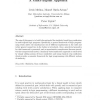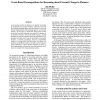313 search results - page 34 / 63 » Building Models through Formal Specification |
CMOT
1998
13 years 8 months ago
1998
A programming language which is optimized for modelling multi-agent interaction within articulated social structures such as organizations is described with several examples of it...
EUSFLAT
2001
13 years 10 months ago
2001
The aim of this paper is to build a formal model for similarity-based fuzzy unification in multi-adjoint logic programs. Specifically, a general framework of logic programming whi...
AIPS
1996
13 years 10 months ago
1996
An increasing number of planners can handle uncertainty in the domain or in action outcomes. However, less work has addressed building plans when the planner's world can chan...
CUZA
2002
13 years 8 months ago
2002
This paper presents Process Algebra for Predictible Control Systems (PAPCS) as a model for specifying and analysis of concurrent, time and resource dependent, distributed control s...
JUCS
2006
13 years 8 months ago
2006
: Program slicing is a well known family of techniques used to identify code fragments which depend on or are depended upon specific program entities. They are particularly useful ...


